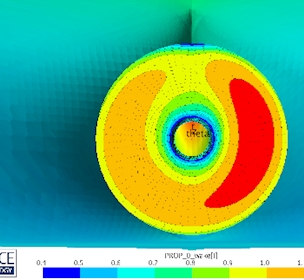Simulating powering in waves can reduce vessel fuel use
Today powering of ships in waves plays an important role since the power estimate gives an indication of the required fuel consumption.
Powering in waves is also relevant from a safety point of view, since it is important to know the minimum required power for the ship sailing in waves and still having engine power enough to operate safely. Recent development in optimized hull forms and slow steaming have led to less installed engine power, which is of concern for IMO, since there is a lower limit for the installed power to still manoeuvre safely in rough weather.
Till now, most literature concerning CFD studies carried out for ships in waves relates only to added resistance and motions in waves, as including a propeller in a wave setup is not trivial, since the complex propeller and wake flows overlaid with the wave orbital velocities and the moving hull must be resolved.
The complexity is also why, until recently, direct measurement of added powering due to waves are primarily carried out during towing tank testing by performing self-propulsion tests in calm water and in waves. In the early design phase however, where the final hull form has not yet been determined, CFD may as well be used as an alternative to simulate the ship in calm water and waves in a setup like the towing tank.
Potential flow codes vs. RANS CFD
Due to improving CFD capabilities and computational resources, added powering calculations can easily be executed using numerical simulation models. While simplified codes such as potential flow codes have been used in the past to estimate vessel performance, these codes are inviscid and often limited by linearization assumptions. State of the arts is to use RANS CFD codes for the purpose, as they offer the possibility to do wave computations without many of the limitations related to potential theory.

To analyze the added powering in waves of a ship, the calculations will be performed with the high efficient Reynolds Averaged Navier-Stokes (RANS) solver StarCCM+. Since FORCE Technology has many references and validation data for model tests, the CFD simulations for added powering will also be performed in model scale.
In terms of numerical prediction, the CFD calculations from FORCE Technology deviate approximately 2-3% from the measured model test data with regards to average and first order amplitudes of the motions, thrust and torque.
Power demand optimization
To predict the power demand in waves, numerical self-propulsion simulations will be carried out based on the propeller open water characteristics. We developed a simplified body force propeller model to include the propeller effects in their RANS CFD simulations.
Along with the prediction of the motion, thrust and torque, the variation of the efficiency, thrust deduction, relative rotative efficiency and the wake fraction, i.e. the average axial velocity over the propeller disk, can efficiently be estimated for all wave conditions of the test matrix.

Next step
Wave simulations based on RANS offers the possibility for calculating both flow field, forces and motions with one tool, so seen in the light of the promising results for added powering in waves, the next natural step will be to apply RANS for manoeuvring in waves as well, releasing the model in all 6 degrees of freedom.




